Research: Chemical Energy Conversion and Power Generation at the Microelectromechanical Systems (MEMS) Scale
David L. Milius
In collaboration with:
- Frederick L. Dryer,
Mechanical and Aerospace Engineering, Princeton University - Richard A. Yetter,
Mechanical Engineering, Pennsylvania State University
The aim of this study is to investigate the feasibility of two innovative concepts for converting chemical energy into electrical energy using piezoelectric membranes and micro-manufacturing technologies, with particular emphasis on techniques that show promise for applications to MEMS. A prototype microcombustor has been developed for micro-scale combustion of gaseous fuel and air mixtures. It uses a catalyst (platinum) deposited on the internal walls of the channels to lower the range of the operating temperature. The spiral, "Swiss roll", design provides a number of desirable features, such as:
- Thermal energy transfer mechanism to preheat the reactants using the exhaust heat
- Combustion volume (possibly pressurized)
- Relatively large internal surface/volume ratio needed for the heat transfer through the walls and for effective action of the catalyst
- Relatively large top and bottom surface area for the heat transfer to external devices
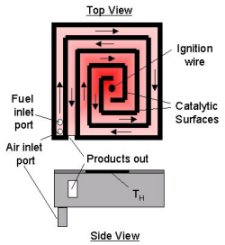
The Swiss roll device consists of two parallel spirals connected by a vertical via. The air fuel mixture is heated in the inlet spiral and ignites; the combustion products continue through the outward spiral, transferring heat to the incoming air/fuel mixture.
Stereolithography is used to fabricate the reactor. This process builds the reactor using a photo-curable polymer in an electro-sterically-stabilized ceramic suspension. After drying, the reactor is reactor burned out at low temperatures and sintered at high temperatures (1550°C) to full density. A cross section of an alumina burner is shown below where one of the two interconnected spirals can be seen.
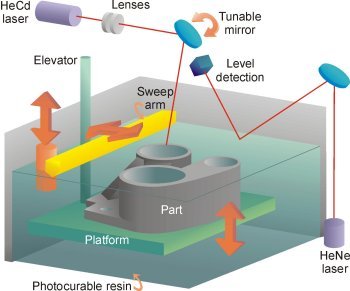
Stereolithography is used to cure a photocurable suspension of ceramic starting on the platform just at the surface of the suspension. Each x-y layer is built 0.075 mm at a time, one on top of the other until the very top of the part is built, the platform keying down 0.075 mm per layer, until the last layer is cured when the platform is the height of the part below the suspension surface.
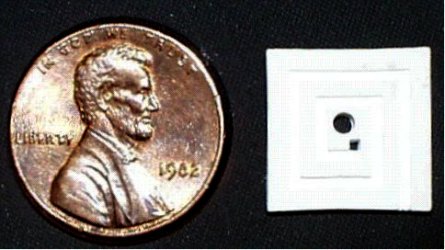
Cross-section of alumina burner produced using stereolithographic methods. Note square via hole that would connect this spiral to the 2nd parallel spiral 1 mm away.
The reactor uses flameless catalytic ignition to burn the air/fuel mixture. This allows the reactor to operate below 300°C. To obtain catalytic ignition requires two post-sintering steps. The first is to coat the inside walls of the reactor with a fine gamma-alumina powder and adhere the powder to the walls by calcining at 800°C. The second step is to coat the gamma-alumina with platinum metal using an organic precursor that is reduced by forming gas to metallic platinum. The following figure is a SEM micrograph of the high surface area platinum-coated gamma-alumina.
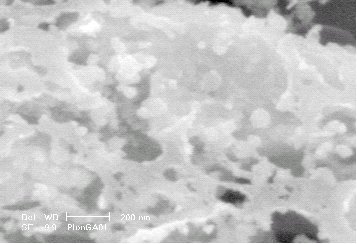
High surface area gamma alumina washcoat on alpha alumina burner interior surface provides support and segregation for platinum catalyst.
The reactor is then ready for converting chemical energy directly into electrical energy using thermoelectrics. Below we show a reactor sandwiched by two thermoelectric modules connected in series. When combustion is obtained in the burner, the thermal gradient across the two modules produces enough current to light a small light bulb.
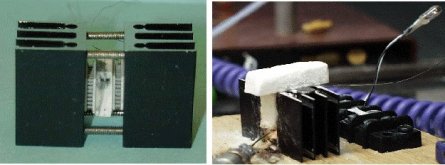
In the lefthand picture a burner is shown on edge sandwiched by Peltier thermoelectric modules that provide current directly from a thermal gradient. In the righthand picture the system burns an air/fuel mixture and converts the heat to electricity, lighting a small LED lamp (upper right hand corner).
References
1. P.B. Koeneman, I.J. Busch-Vishniae, and K.L. Wood, "Feasibility of Micro Power Supplies for MEMS," J. MEMS 6 [4] (1997).
2. M.K. Drost, C. Call, J. Cuta, and R. Wegeng, "Microchannel Combustor/Evaporator Thermal Processes," Microscale Thermophysical Engineering 1 31-32 (1997).
3. T.A. Ameel, R.O. Warrington, R.S. Wegeng, and M.K. Drost, "Miniaturization Technologies Applied to Energy Systems," Energy Convers. Mgt. 38 [10-13] 969-82 (1997).
4. D.R. Hardesty and F.J. Weinberg, F.J., "Burners Producing Large Excess Enthalpies," Comb. Sci. and Tech. 8 201 (1974).
5. F. Weinberg, "Heat Recirculating Burners: Principles and Some Recent Developments," Comb. Sci. & Tech. 121 3 (1996).
![]() 6. R.
Garg, R. K. Prud'homme, and I. A. Aksay, "Optical transmission in highly
Concentrated Dispersions," J. Opt. Soc. Am. A 15 [4] 932-5
(1998).
6. R.
Garg, R. K. Prud'homme, and I. A. Aksay, "Optical transmission in highly
Concentrated Dispersions," J. Opt. Soc. Am. A 15 [4] 932-5
(1998).
For more information on this research topic, please contact David Milius. Additional information concerning the CML can be found on our website.
![]()
![]()
![]() © 2001 Princeton University, Ceramic Materials Laboratory.All Rights Reserved.
© 2001 Princeton University, Ceramic Materials Laboratory.All Rights Reserved.


